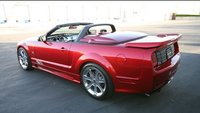Even before they put the live axel on mustangs, it has been said to cause problems in handling. So if the live-axel is causing the stang to do poorly in handling, then why does ford keep it??
6 Answers
it helps on the dragstrip,and i think thats the main thing mustangs are for....
I would imagine that it also helps keep the price point down as well.
a live rear end is structurally more solid than an IRS, thus allowing the vehicle to handle more power than an IRS (see: 2003-2004 Cobra). The trade off is of course, poor handling under certain circumstances. However the engineering dollars behind a live rear end is much more affordable, so they can afford to put more into the rest of the vehicle and uphold Mustang's time-honored and undeniable tradition of providing a quality high performance touring car at an affordable price to the masses, while still offering a level of refinement that would not otherwise be expected. Yes there were the dark year of the "Mustang Also," but that was what was needed to let the car survive. I personally agree however that at least a VARIANT of the mustang needs to have an IRS set-up out back. Ford seems to have a handle on things however, as a recent testing of the 2011 model with the track pack shows it competently handling track times with am M3, which has an IRS. Mustang also currently maintains lateral acceleration of approx. .95g with the track pack installed, with only a minimal loss of ride quality... and frankly if you are going for more hardcore performance, you are GOING to lose ride quality anyway, so this is an acceptable trade-off. All in all, Ford has done a good job of keeping the live rear end viable, and scaring the Germans model year after model year, at a fraction of the cost. l2tune solid rear end suspensions.
untrue. Though the mustang IS a strong contender int he drag strip due ot the ease with which it is lightened and the size of the engines that can fit into them, they were NEVER originally intended for the drag strip. The mustang by it's very nature of BEING a pony car is that it has a sizeable, powerful, easy to work on engine in a light chasses that will still allow the vehicle to competently handle on a road course. Other cars in the class do pretty mcuh the same thing, however drag-racing enthusiasts and "tuners" seem to alway find a way to make these cars perform well on the 1/4 mile. There IS no denying that a solid rear axle DOES allow the vehicle to be a more stout natural predator on the drag-strip, but this was never the intended purpose of the car. It was INTENDED to be an autocross car (really it was marketed as a secretary's touring car, but that's neither here nor there). As it happens it has a much more glorious Autocross and GT racing history than it does Drag Racing, but it's Drag success is there. I guess what I'm getting at is, the car is "bred" for the road course. Hence why Ford has consistently made effort to improve it's overall handling and ride quality rather than JUST give t a bigger engine... as it stands a 2010 Mustang GT with the Track Pack installed will out handle a 2010 Camaro SS all day... it may be out accelerated by it, but that's what the GT500 is for. EVen then GT is only MARGINALLY slower. I'm done here. lol.
www.griggsracing.com Holds many NASA records for road racing, all on live-axle. The only real drawback from live-axle suspensions is the lack of tuning for caster-camber. They also do not add negative camber during articulation like a SLA IRS suspension. Properly set up (good rod end LCA's, torque arm, watts link, coil-overs) they can hang with some of the best IRS setups.
